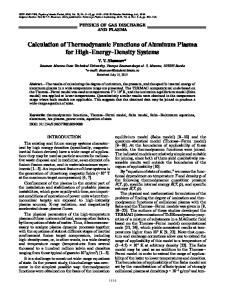Thermodynamic calculation for alloy systems
- PDF / 381,581 Bytes
- 7 Pages / 612 x 792 pts (letter) Page_size
- 6 Downloads / 334 Views
INTRODUCTION
IN the present production practice and scientific research, there is a problem of insufficient thermodynamic data, especially activity data. Although researchers in related fields have done many measurements, the results of experimental measurements are still limited and many systems are still blank in thermodynamic data because of the complications and difficulty of high-temperature experiments. Therefore, an important task for present scientific researchers is to estimate the thermodynamic data according to theory. For years, many solution models have been proposed trying to explain reasonably the change of activity coefficient with concentration. Hildebrand and Scott,[1] Lupis and Elliott,[2] and other researchers have done much work in these fields, but their models are very difficult to use to estimate large quantities of thermodynamic data directly. Miedema et al.’s model for the heat of formation for binary alloys is a very important achievement in recent years.[3] The heat of formation data for almost all binary alloys can be calculated from the most basic properties such as molar volume V, electronegativity f, and electron density nws of elements in the systems. This method is 95 pct successful in predicting the sign of DHij.[4] A comparison of the available values of DHij for 40 binary systems formed by Al, Ti, Hf, Cr, Fe, Co, Ni, Nb, Mo, and W with the calculated values by the Miedema et al. method shows that the differences generally do not exceed 8 kJ/g atom, the largest difference being 17 kJ/g atom within a range of 147 to 262 kJ/g atom for DHij.[4] In our previous publications,[5–8] on the basis of Miedema et al.’s methods and assuming the excess entropy as zero, the thermodynamic models of the activity coefficient of a solute at infinite dilution, expressed in ln gi0 , and the firstand second-order interaction parameters, εii and εij, rii, rij and riizj were established. In this article, the formulas for calculating the activity of components, expressed in ln gi in the binary system, and the activity coefficient of a solute at infinite dilution, exXUEYONG DING and WENZHONG WANG, Professors, are with the State Key Laboratory of Rolling & Automation and CRC EPM Center, Northeastern University, Shenyang 110006, People’s Republic of China. PENG FAN, Associate Professor, is with the Department of Inorganic Materials, Sichuan Union University, Chengdu 610065, People’s Republic of China. Email: [email protected] Manuscript submitted May 17, 1994. METALLURGICAL AND MATERIALS TRANSACTIONS B
pressed in ln gi0, as well as interaction parameters, εii and εij, can be obtained by the Miedema et al.[3] method combined with a few basic thermodynamic relations. II.
ESTABLISHMENT OF MODELS
A. Establishment of Activity Coefficient Formulas Ln gi in a Binary System The relation between the partial molar excess free energy, aMGiE, and the activity coefficient of component i in the binary system i-j at a certain temperature is G Ei 5 RT ln gi
[1]
and the relation between the partial molar excess fre
Data Loading...











